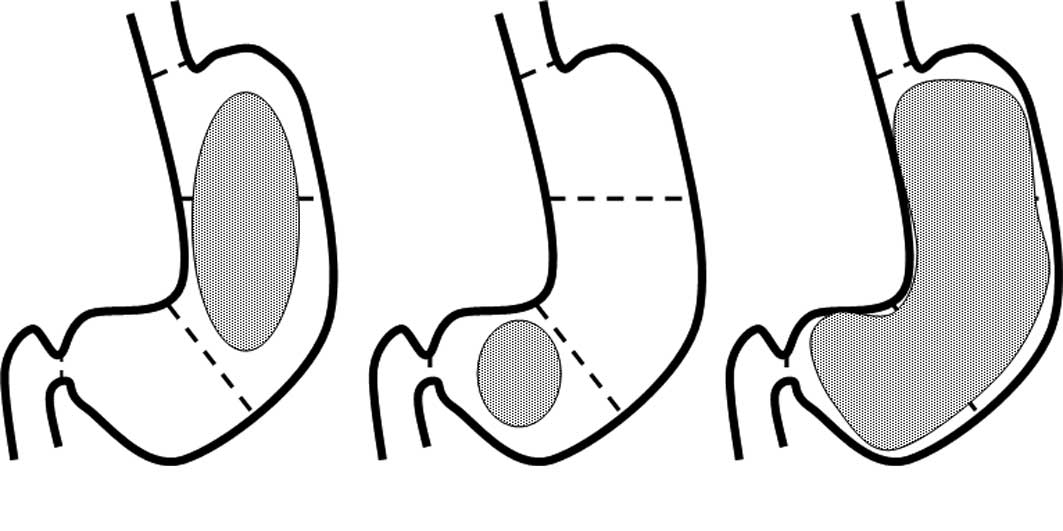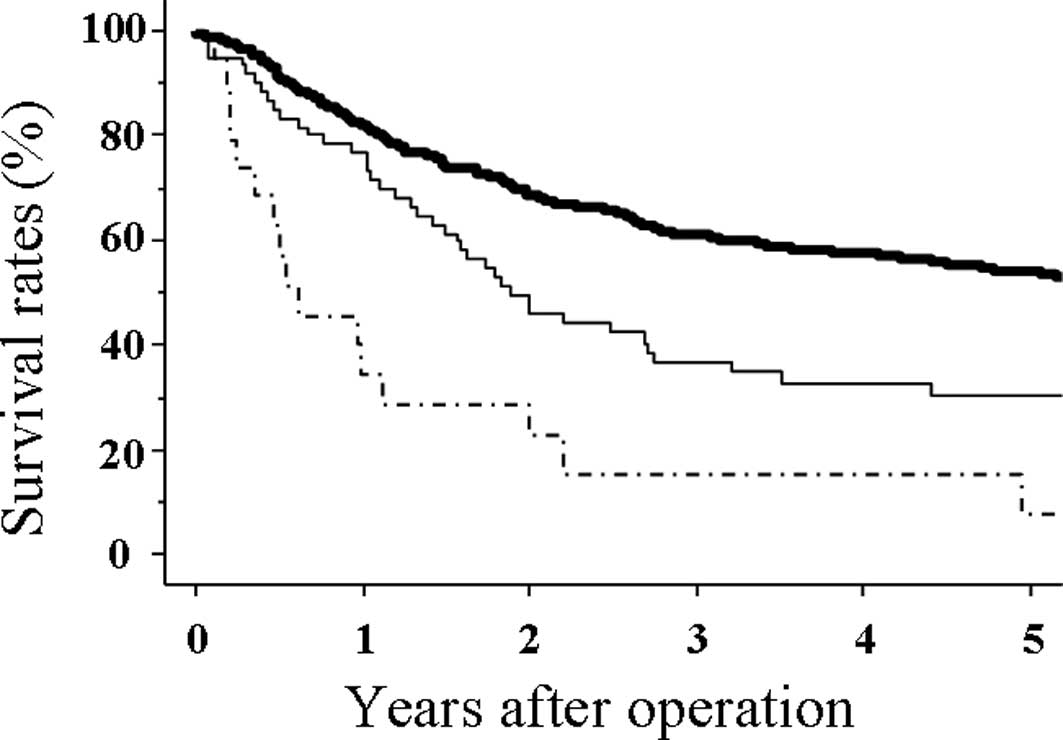|
1
|
Takemura S, Yashiro M, Sunami T, et al:
Novel models for human scirrhous gastric carcinoma in vivo. Cancer
Sci. 95:893–900. 2004. View Article : Google Scholar : PubMed/NCBI
|
|
2
|
Ikeguchi M, Miyake T, Matsunaga T, et al:
Recent results of therapy for scirrhous gastric cancer. Surg Today.
39:290–294. 2009. View Article : Google Scholar : PubMed/NCBI
|
|
3
|
Sasaki T, Koizumi W, Tanabe S, et al: TS-1
as first-line therapy for gastric linitis plastica: historical
control study. Anticancer Drugs. 17:581–586. 2006. View Article : Google Scholar : PubMed/NCBI
|
|
4
|
Kodera Y, Nakanishi H, Ito S, et al:
Detection of disseminated cancer cells in linitis plastica-type
gastric carcinioma. Jpn J Clin Oncol. 34:525–531. 2004. View Article : Google Scholar : PubMed/NCBI
|
|
5
|
Morita K, Fujimori T, Ono Y, et al:
Identification of the prelinitis condition in gastric cancer and
analysis of TGF-b, TGF-b RII and pS2 expression. Pathobiology.
69:321–328. 2001. View Article : Google Scholar : PubMed/NCBI
|
|
6
|
Matsukawa M, Kurihara M, Hirashima M, et
al: Radiological findings of gastric scirrhous cancer. Gan To
Kagaku Ryoho (in Japanese with English abstract). 21:2378–2383.
1994.PubMed/NCBI
|
|
7
|
Oguro Y: Endoscopic diagnosis of scirrhous
gastric carcinoma. Gan To Kagaku Ryoho (in Japanese with English
abstract). 21:2384–2391. 1994.PubMed/NCBI
|
|
8
|
Kohri Y, Takeda S and Kawai K: Earlier
diagnosis of gastric infiltrating carcinoma (Scirrhous cancer). J
Clin Gastroenterol. 3:17–20. 1981. View Article : Google Scholar : PubMed/NCBI
|
|
9
|
Ichikawa Y, Koshikawa N, Hasegawa S, et
al: Marked increase of trypsin(ogen) in serum of linitis plastica
(gastric cancer, Borrmann 4) patients. Clin Cancer Res.
6:1385–1388. 2000.PubMed/NCBI
|
|
10
|
Kitamura K, Beppu R, Anai H, et al:
Clinicopathological study of patients with Borrmann type IV gastric
cancer. J Surg Oncol. 58:112–117. 1995. View Article : Google Scholar : PubMed/NCBI
|
|
11
|
An JY, Kang TH, Choi MG, et al: Borrmann
Type IV: An independent prognostic factor for survival in gastric
cancer. J Gastrointest Surg. 12:1364–1369. 2008. View Article : Google Scholar : PubMed/NCBI
|
|
12
|
Naito Y and Kino I: Pathogenesis and
progression of scirrhous carcinoma. Gan To Kagaku Ryoho (in
Japanese with English abstract). 21:2364–2370. 1994.PubMed/NCBI
|
|
13
|
Ikeguchi M, Yamamoto O and Kaibara N:
Management protocol for scirrhous gastric cancer. In Vivo.
18:577–580. 2004.PubMed/NCBI
|
|
14
|
Otsuji E, Kuriu Y, Okamoto K, et al:
Outcome of surgical treatment for patients with scirrhous carcinoma
of the stomach. Am J Surg. 188:327–332. 2004. View Article : Google Scholar : PubMed/NCBI
|
|
15
|
Kunisaki C, Shimada H, Nomura M, et al:
Therapeutic strategy of scirrhous type gastric cancer.
Hepatogastroenterology. 52:314–318. 2005.PubMed/NCBI
|
|
16
|
Ikeguchi M, Matsumoto S, Yoshioka S, et
al: Laparoscopic assisted intraperitoneal chemotherapy for patients
with scirrhous gastric cancer. Chemotherapy. 51:15–20. 2005.
View Article : Google Scholar : PubMed/NCBI
|
|
17
|
Japanese Gastric Cancer Association.
Japanese Classification of Gastric Carcinoma – 2nd English edition.
Gastric Cancer. 1:10–24. 1998.
|
|
18
|
Sobin LH, Gospodarowicz MK and Wittekind
C: TNM Classification of Malignant Tumors. 7th edition. A John
Wiley & Sons, Ltd; NY: pp. 1–310. 2009
|
|
19
|
Borrmann R: Geschwulstic des Magen und des
Deudenums. Henke F and Lubarsch O: Handbuch der Speziellen
Pathologischen Anatomic und Histologie. IV(part 1)Springer; Berlin:
pp. 812–1054. 1926
|
|
20
|
Nakamura R, Saikawa Y, Wada N, et al:
Retrospective analysis of prognosis for scirrhous-type gastric
cancer: one institution’s experience. Int J Clin Oncol. 12:291–294.
2007.PubMed/NCBI
|
|
21
|
Kodera Y, Yamamura Y, Ito S, et al: Is
Borrmann type IV gastric carcinoma a surgical disease? An old
problem revisited with reference to the result of peritoneal
washing cytology. J Surg Oncol. 78:175–182. 2001. View Article : Google Scholar : PubMed/NCBI
|
|
22
|
Li C, Oh SJ, Kim S, et al: Macroscopic
Borrmann type as a simple prognostic indicator in patients with
advanced gastric cancer. Oncology. 77:197–204. 2009. View Article : Google Scholar : PubMed/NCBI
|
|
23
|
Chen CY, Wu CW, Lo SS, et al: Peritoneal
carcinomatosis and lymph node metastasis are prognostic indicators
in patients with Borrmann type IV gastric carcinoma.
Hepatogastroenterology. 49:874–877. 2002.PubMed/NCBI
|
|
24
|
Park MS, Ha HK, Choi BS, et al: Scirrhous
gastric carcinoma: endoscopy versus upper gastrointestinal
radiolography. Radiology. 231:421–426. 2004. View Article : Google Scholar : PubMed/NCBI
|
















